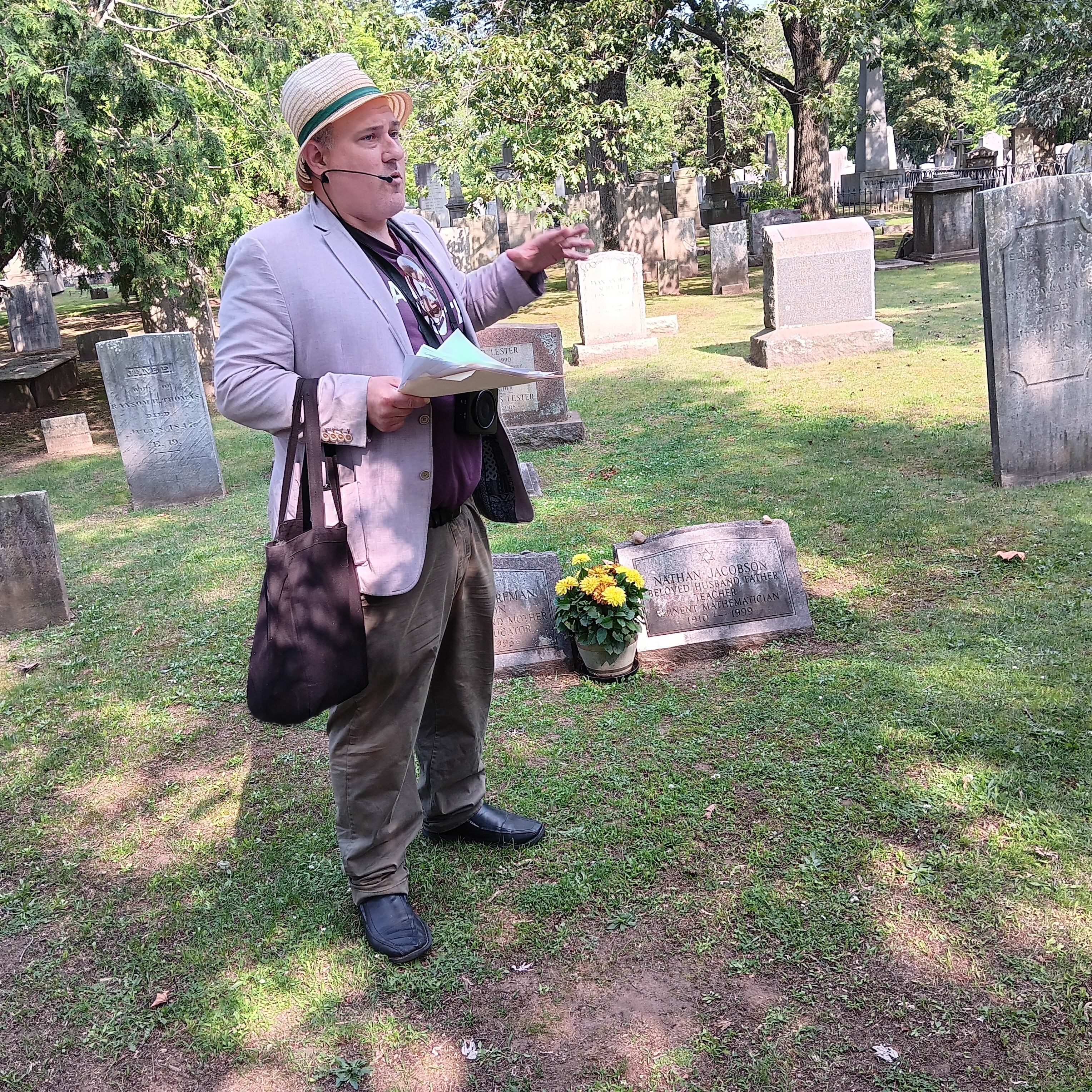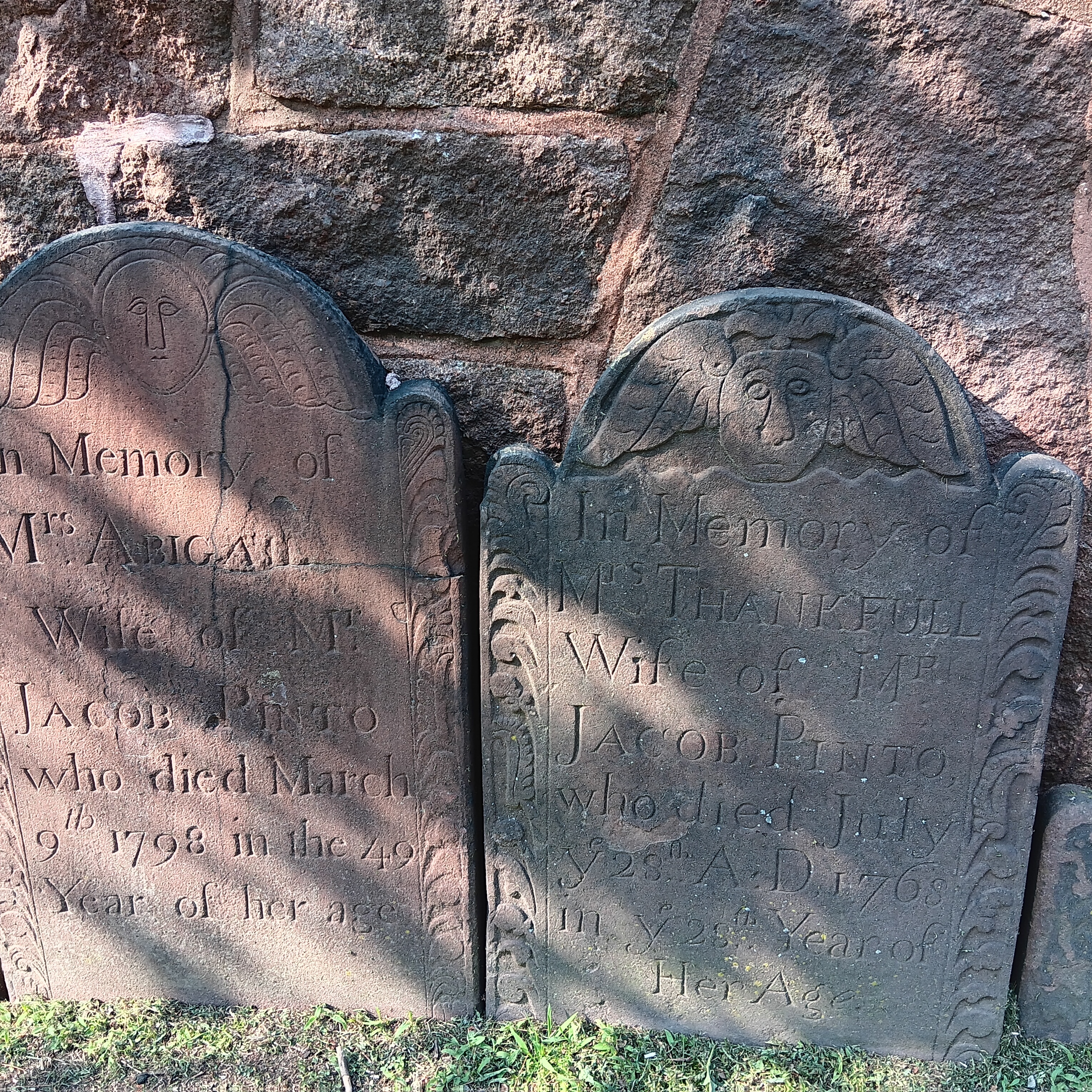
Jewish Historical Society tour leaders Aaron Goode, Michael Dimenstein, Cindy Leffell.
“The dead shall be raised,” a quotation from Corinthians, with sources in early Jewish literature, is inscribed across the Egyptian Revival style gateway lintel at Grove Street Cemetery.
And Yale University President (1899 – 1921) Arthur Twining Hadley — among others — is alleged to have quipped that such removal will certainly be the case if Yale requires the property.
The small joke is also of course on Hadley who, along with 14 other Yale presidents, is buried at the Grove Street Cemetery.
His tree-shaded grave site, interestingly, was among the dozen plus visited on a recent “Jewish tour” of our great National Historic burying ground.
Why Hadley?
Because, explained one of the tour leaders, Aaron Goode, who is a board member of the tour-organizing Jewish Historical Society of Greater New Haven, Hadley was responsible, beginning in the 1920s, for instituting quotas on Yale’s admission of Jewish students that remained in place for decades to come.
On a hot, sunny Thursday last week, Goode and Cindy Leffell, a member of the “standing committee” or board of Grove Street Cemetery, guided 30 people amid New Haven’s serene and beautiful 18-acre necropolis, where, beginning in 1797, 14,000 have been buried, including approximately 100 Jewish people.

Goode by the grave of eminent Yale mathematician Nathan Jacobson, one of the first to display Jewish symbols.
“I had no idea Jews were buried here,” said long-time Westvillian, lawyer, and former alder Ina Silverman.
“It’s typical,” said the society’s president, Michael Dimenstein, “even for the un-affiliated to be buried in Jewish places.”
And yet is there any Jewish law that says Grove Street isn’t kosher?
As she welcomed the tour-goers, Leffell, who was smitten with the “beautiful, meditative labyrinth” of Grove Street through taking many walks there over the years, said she checked in with her rabbi on the matter before she and her family purchased a plot at Grove Street.
“He said there’s nothing halachik [that is, legal] that prevents you [from being buried here.] Your community in life should be your community in death,” she reported that her rabbi had advised.
“I was touched by the rabbi’s argument and I took it to heart,” Leffell said, as she began to notice on her walks the many Jewish names and decided to create a database.
“Many of those buried here had strong ties to the city, to Yale, to the beauty of the place, to others who were buried here,” among other reasons for their choice, she added.
There was never any official prohibition as the cemetery was established, among its many pioneering distinctions (including being organized with named streets or lanes, like a city, as well as innovating family plots) as the country’s first non-sectarian non-church affiliated public and city cemetery; from the beginning it even set aside a section for the poor.
All this was occasioned as burials on the Green had run out of space, and among the first Jewish headstones (though not the bodies) transferred from the Green to Grove Street were those of the sisters Abigail and Thankful Pinto.
Actually they were not themselves daughters of Israel but both became wives (though not at the same time) of the pioneering early 19th century Sephardi Jewish merchant Jacob Pinto, whose house, with his brother William, is preserved on Orange Street.

Tombstones of Abigail and Thankful Pinto.
Although a few also date from the Colonial period, most Jewish burials date from 1970 or so and onward, Leffell explained.
Here are a few highlights of the tour, including graves of non-Jews like Hadley, that reflect what Aaron Goode called the 275 years of New Haven Jewish history that are also a microcosm of all American history, especially immigration, which is once again at the core of the hot debate about national identity.
“Great scholars are a dime a dozen [in Grove Street],” Goode said as we stood over one of his favorites, the grave of Nathan Jacobson. This “modest genius of a mathematician ‚” per Goode, was a student of Albert Einstein and Alan Turing, and through championing Russian mathematicians might have earned his way onto a KGB wanted list for his vigorous defense of the cause of Soviet Jewry in the 1980s.
Next stop was Alfred Whitney Griswold, another Yale president (you don’t have to use it, but a free burial spot at Grove Street, Goode explained, is a perk of the job) and he is the antidote to Hadley.
Goode said in the 1960s Griswold effectively lifted the Jewish quotas that Hadley had set. A believer in liberalism and humanistic education and, to Goode’s mind, the greatest of Yale’s presidents, he also pioneered a first kosher kitchen for Jewish students and green-lighted establishment of the first Judaic Studies department at Yale.
On Magnolia Avenue we encountered a descendant of the Jewish pirate Moses Cohen Henriques, a forcibly converted Iberian Jew who played an essential role in the Dutch take-over of Brazil in the early 17th century.
“Think Johnny Depp with a yarmulke,” quipped Goode. The grave belongs, however, not to the pirate, but to Sarah Mendez, the wife of his great grandson, a family that came to New Haven as our city and its port became part of the triangular trade in sugar, other raw materials, and enslaved people during the colonial period.
We passed the recent marker of the much loved Judith Ann Schiff, city historian of New Haven, and Rollin G. Osterweis, also a city historian of New Haven and in 1943 the first Jewish professor to be appointed to a tenure track at Yale.

Historian Rob Forbes and realtor Jeff Granoff with Jewish pirate research.
Part of the mid-19th century first significant wave of German Jewish immigrants to New Haven, Osterweis’s family predecessors established a cigar factory in town in the 1860s, explained Lefell, and he went on to “integrate” many of Yale’s and the city’s elite establishment circles.
Murmurs of recognition emerged from the tour attendees, especially the guys, as we stopped at the grave of architect David Podoloff, a member of a family of engineers and impresarios who were “towering figures in American sports,” per Leffell and Goode. The family revived the Arena on Grove Street as a concert venue, invented the Ice Capades, and went on to other innovative achievements like the creation of the National Basketball Association.
The two tall stone rectangles marking the graves of architect Herb Newman and his wife Edna Lee stand at an angle with a small line of open space and light separating them. The lovingly designed monument, said Leffell, who was close with the Newmans, takes in the movement of the earth; the calculation is over time, these stones will touch each other and love, with a little help from architecture, will have triumphed over death.
Leffell is continuing to research names to add to the database. The historical society’s archivist Nicole Zador said she will be working with Leffell to make that database searchable by the public in the months ahead.

The Newmans.